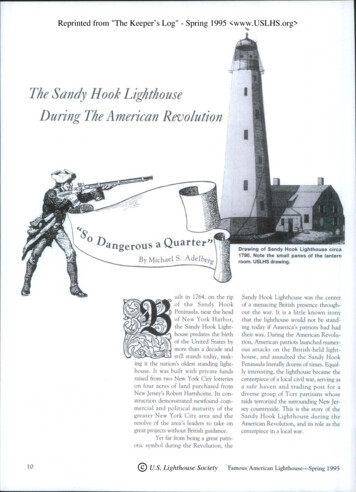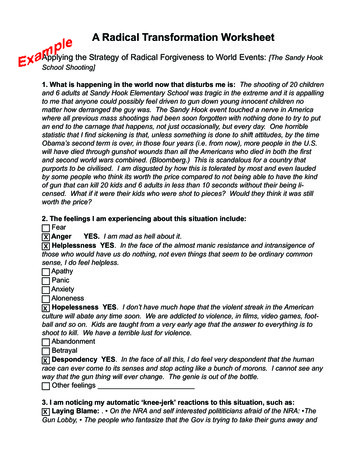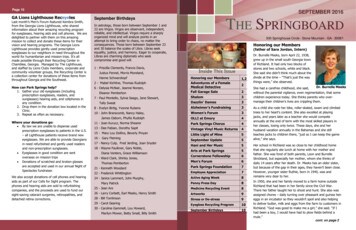
Transcription
Reprinted from "The Keeper’s Log" - Spring 1995 www.USLHS.org 444The Sandy Hook LighthousemDuring The American Revolution4114-4*-I.·-'1 ./I.-,03A«1./-./-./ :.3-5/5.-5- --Scir'44i':.--.t * 24 %:/.·-2.S«0-4SHrIM»I./S» l», 7r. --c Oh angerous a Quarter" i7--0.-4huilt m 1764, on the tipSandy Hook Lighthouse was the centerthe Sandy HookPeninsula, near the headof New York Harbor,the Sandy Hook Lighthouse predates the birthof the United States byofa menacing British presence throughout the war. It is a little known ironythat the lighthouse would not be stand-of37P--,e .Drawing of Sandy Hook Lighthouse circa1790. Note the small panes of the lanternroom. USLHS drawing.By Michael S. Adell)ergP.1.-ri.-ing today if America's patriots had hadtheir way. During the American Revolution, American patriots launched numerthe British-held light1 morethana decade and ous attackson'' - cstillstands today, makandassaultedthe Sandy Hookhouse,ing it the nation's oldest standing lightPeninsula literally dozens of times. Equalhouse. It was built with private fundsly interesting, the lighthouse became theraised from two New York City lotteriescenterpiece of a local civil war, serving ason four acres of land purchased from a safe haven and trading post for aNew Jersey's Robert Hartshorne. Its condiverse group of Tory partisans whosestruction demonstrated newfound comraids terrorized the surrounding New Jermercial and political maturity of the sey countryside. This is the story of ther .,1, )Fgreater New York City area and the Sandy Hook Lighthouse during theresolve of the area's leaders to take ongreat projects without British guidance.Yet far from being a great patriotic symbol during the Revolution, theU.S. Lighthouse Society10-American Revolution, and its role as thecenterpiece in a local war.Famous American Lighthouse-Spring 1995
Reprinted from "The Keeper’s Log" - Spring 1995 www.USLHS.org The British Conquest of theLighthouseenemy, you will pump it on theground. In short, you will use yourbest discretion to render the lightThe first half of 1776 was a veryhouse entirely useless.„unusual time. Americans and British hadOn March 8, Malcolm's party, escortalready fought what was the bloodiested by Taylor and a few local militiamen,battle of the Revolution, the so-calledlanded at Horseshoe Bay, halfway up theBattle of Bunker Hill, yet most AmeriSandy Hook Peninsula, and proceeded tocans outside of New England still considthe lighthouse. Once there, they accomered themselves loyal English citizens. Inplished their task, and Colonel TaylorNew York City, this unusual situationreturned home with a number of itemstranslated into an awkward stalemateVital to the lighthouse, including: eightbetween the local patriots who concopper lamps, two tackle falls and blocks,trolled the docks of the city, and Rearthree and a half casks of oil, and otherAdmiral Peter Parker's small squadron ofsundry items. The lantern glass proved toBritish naval vessels. By spring, a tensebe more difficult to handle. Winthropstandoff existed between the two sides,Sargent, in his report to George Washaggravated greatly by the constantington on the lighthouse mission, notedrumors of a British invasion of New Yorkthat, "Major Malcolm found it impossibleand a steady influx of Continental solto take out and save the glass, for want ofdiers from New England.tools and by reason of the time necessaryRumors of the British invasionfor that purpose, and was therefore obligfocused the attention of New Yorkersed to break it." However, neither Taylorand New Jerseyians on Sandy Hook. Thenor Malcolm stayed at the Hook and thelarge British ships, most of which wouldlighthouse, now crippled, was leftbe navigating the tricky waters aroundunguarded.Sandy Hook for the firstwouldMeanwhile, life grew ever more miser-able for Rear Admiral Parker's smallnaval squadron. Though bristling withcannon, the warships were no match forthe coordinated boycott and daily harassment of the New Yorkers. Equally alarming for the British, was the ever-growingof Continental soldiers who, onattacked and captured most of aBritish party sent to Staten Island to getfresh water. Unable to dock or draw provisions from New York, Parker moved hissquadron across to the New Jersey side ofpresenceAprilthe harbor. His squadron relocated toSandy Hook on April 8,1776.Desperate for fresh water, parties ofBritish sailors started coming ashom onthe Sandy Hook Peninsula in April. It isunclear how many British watering parties landed and departed safely in earlyApril, but this grace period did not lastlong. On April 23, 1776 a company ofNew Jersey State Troops, under CaptainVandeput, surprised and captured a thirty-five man watering party from theHMS Asia as they camped below thetime,need the Sandy Hook Lighthousethe pilots who stayed there to avoidgrounding on the sandbars at the head ofand7,-tS.New York Harbor. Lacking the navalpower to resist a British invasion, patriotleaders hoped to hamper the Britishinvasion by destroying the Sandy HookLighthouse. On March 4, 1776, the NewC bill Xif possible; but if you find it impossible, you will break all the glass.You will endevour to pump the oilout of the cisterns into casks and\ p'1 1/lilizE,al,Q'Fit:I';.Jersey Provincial Congress resolved todismantle the Sandy Hook Lighthouse,and designated Colonel George Taylor,of the local Monmouth County Militia,to lead the operation. Just two days later,the New York Convention of Delegatesfinalized its plans to send Major WilliamMalcolm to Sandy Hook to accomplishthe same task. Malcolm's orders wereexplicit. He was to proceed to Middletown, New Jersey, link up with Taylor,and then go to the lighthouse. Oncethere, he was instructed to:"You will endevour to take thelight out of the lantern, and save itH9,11 p. 11 1-j„„.111, "\\1 Ii' ,·,t 1 ' ; 1011111111'llw'll'Il'Ill"lillI,1111,,,I,1 111',3" "Log-Spring 1995Nfi.*B- ,ithi,.L .2,0. - El'.iHRi/101\\ \ l i l i 'i i l. L \»Liv-.iM „-1,0.\/U1-l Er3.Ln ,44bring it off; but if youshouldby thebeobstructed in your tasksThe Keeper'sIfQ#it, ,J .,12'J.3 1136,--U.S. Lighthouse Society11
Reprinted from "The Keeper’s Log" - Spring 1995 www.USLHS.org lighthouse. The next day another smaller the time the invacling British armadabegan arriving from Halifax at the end ofBritish watering party was also captured;the New York lournal reported the inci- June, the lighthouse was again fully operdent:ational.We hear from Sandy Hook, that 16Meanwhile, the British continued tomen from one of the ships of war,secure their position on the Hook. Mosthaving landed there in order to getimportantly, the British kept at least onesome water, they all had gottenlarge naval vessel at Horseshoe Bay virtuinto the upper room of the lightally all of the time, a wise precautionhouse, where they were carousing,when a party of New Jersey Militiasurprised them, taking away the:lower part of the stairs, made them',&11fprisoners, burned their boat andafilled up the well.:31: .Es i 3r- hese humiliating little defeats4letprompted the British to take.9, -S::.1 action. Some time shortly afterIsi,O -,they continued throughout the entirewar. The British further strengthenedtheir position on 'the Hook' by keeping acompany of marines stationed in thelighthouse and a corporal's guard oftwelve marines camped by the freshwater well near the southern end of thepeninsula. Lighthouse keeper, AdamDobbs, an employee of the New YorkSKETCH OFSANDYHOOK with thetemporary worb lately conftructed 14i.0,3-a :pij.1jthereon,jhewing * the pofition5,fthe Brigh.1'ofa French Fleetj underthe command ofthe RE Honble.Lord V#iount Howe 6Mo'11) le Comte D'»ing117 e't Alb 1the capture of the watering parties, RearAdmiral Molyneaux Shuldham, nowcommanding the Sandy Hook squadron,landed a large body of marines and cap-*·t,#ek 40 . f.5r,meSo.'8.&34:.Ir·.2.224 July 1778.sandy Hook5/». 943.::'., P.ef « i' ighmousetured the lighthouse, apparently without5,001 o Expirija fight. On April 29, Captain Hyde Park'b-:.buck T.1.'.1 1'' c.444 e -Richmond 11 )er of the Royal Marines wrote to Shuldr ff „ rAmazon' carcale 1416ham that he had "put the lighthouse in a, .1,6, rr 1 18.bule 1 5·state of defence." Thethan just capture the lighthoMayuse. OnBritishdidmore1HOr. *9\ 1f \1, the Pennsylvania Journal reported that.t \1\the British were taking a number of steps-1 -6'to secure Sandy Hook. These included3 3moving a frigate, the HMSDuchess ofc& SGordon, close enough to the lighthousecannonso that itscould drive offwould1211&&,Infan,r, 111be attackers. Also, to better protect thelighthouse by depriving would-be attackers of cover, a party of marines under1/11Captain Parker "found itexpedient toburn down the Pilot House at the Hook."All of these precautions apparently paidoff, for when the Jersey State.:S 1\/0S.i,1.U,Troopsattacked a watering party again on May13, they were driven off by the guns ofthe British warships and the appearanceof a party of marines, from the nearby/demonstrated that the lighthouse andthe Sandy Hook Peninsula were nowfirmly controlled by the British. Sometime that month a beacon was built onehundred yards from the lighthouse, tosubstitute for the lighthouse until thelight could be repaired. Yet the beaconj00li 1, 115 16 11, 3L./lighthouse.This skirmish of May 13, 1776,2 114 4' V»·J ""si36 *4Frigatewas not needed for long, for by June thelighthouse was operating again. And by12Frigate 12.U.S. Lighthouse SocietyFamous American Lighthouse-Spring 1995
IReprinted from "The Keeper’s Log" - Spring 1995 www.USLHS.org happened nextafter the action:1 advanced within 150 yards of thelight.house in so secret a mannerthat my party was undiscovered, Iadvanced with an officer andas to the strength of the British garrisonimpression.Tupper's party retreated when thenearby HMS Phoenix joined the fight.Despite being out in the open and takingtwo sides, Tupper's party sufferedfire ondesired to speak with the commanding officer, and after a fewwords he fired several shots at me,but as God would have it, he mist(sic) me. I returned to my partyand ordered the artillery to play,which continued for about anon the Hook. The first phase of the battle for Sandy Hook was over.American Attacks on theLighthouseWhile the British were masters of thelighthouse by May, 1776, their hold onthe Hook faced a series of challenges»some formidable, some inept-from awide variety of patriot opponents: Continental soldiers, local militia, privateersailors, and even a mighty French fleet.The first of these attacks on the lighthouse was launched by three hundredContinentals under the command ofLieutenant Colonel Benjamin Tupper ononly two casualties.A larger party of five hundred men,presumably New Jersey Militia, attackedthe Hook on July 3 but fared even worsethan Tupper's party. Again, the party wasable to get two cannon (firing six poundballs) within firing range of the lighthouse, and again the party was driven offafter discharging several shots on thelighthouse. This time the attackers sus-.LGARIR.tained-ing that the first part of the expeditionwent well: "Set out towards the light-./':/5.-, 1 -"I /IIiiwi .and in high spirits." Tupper's mena British officerexpect it (the lighthouse) will be·attacked again soon, but we are well pre-pared for them." Over the next year,hous (sic) and marched slowly, undiscov-presentlosses,of whom we hear is a Major." The twoattacks on the lighthouse apparently didnot shake the confidence of the defenders; the same British officer noted, "Weii., I.%* a .more severenoted, "they killed 14 of the rebels, one.1 :'.:June 21, 1776. One of Tupper's men,Solomon Nash, described the event, not-ered by the Enemy, we were allhour, but found the walls [of thelighthouse] so thick as to make nois recorded in a letter hecomposed to George Washington the dayCity and presumably a patriot, was placedunder house arrest and confined to thelighthouse. His services were probablyneeded in running the lighthouse andthe British certainly were not eager tohave him inform the Continental Army,New Jersey Militia detachments attackedA' :. .-: r:'. ilial 4-1. .- I5 - -,Al-//e/.-the lighthouse four more times, eachtime being driven off without damagingthe lighthouse.What accounted for the great successthe British defenders 2 Perhaps thegreatest reason for British success had todo with weakness of the Americanattackers, who rarely had the heavy can.non necessary to damage the lighthouse,and never showed the discipline toendure a sustained counter-attack. Near-embarked at dawn and marched within-of150 yards of the lighthouse. In the mom*rt:'1!:91ing sunlight and without opposition, theySandy Hook tower sometime afterAbove187Os, due to the presence of the oil housetrained their two cannon on the lightat the base of the tower. Note the smaller,house. Then Tupper, demonstrating the-1 , .·'-r·T'. . - -"modern" lantern and the keeper. BelowA drawing of the Sandy Hook tower on areceipt for "light dues" paid by all shipsentering New York Harbor prior to 1789.over-confidence of an inexperiencedcommander, marched forward to demandthe surrender of the lighthouse. What4--Pe-'.FORTOFNe rk1-)L.c 2,·cJ.ly as important a factor in assuringBritish victory was the geography ofSandy Hook. The Sandy Hook Lighthouse sits at the end of the long and thinlfu90/ fSandy Hook Peninsula; this allowedrz:ul239''f/(70 nF.,1.z.ija.nitfile*/2*frf, 2;*lent.(26/i .1- 'of .jf.l,zut'LLit· :1- "ACIut 4tfu,. - --·.h, '113:11"f 441-.J umwdnq.9 -1,„,1 N. I LUL -4.,2,'1 c.r) 1 l.t L.800;ourut l.,r ar, 1.& L J d,Jim ef32&&#Al JA,ke.Lifol 9 31-/kill i,e.ttit-rB'i.,29.4 it:2 .), nr,Jp JoT, dry- or I , SACA, ,ik,Imnco of,13.i,jht-Fo".2 u,w„ .4,"lfle»06-8ft,Irtw 0f (,Gv.af , '*.-44, .:9 0,1iaa J,nilt efz"6-The Keeper's Log-Spring 1995British naval vessels to move in close tothe attackers and pepper them with can-non fire. Furthermore, attackers had toventure out into the open to make theirassault. Lawrence Hartwick, a carpenterin the British navy, noted that the lighthouse was 525 yards from the nearest tallgrass meadow, and 735 yards from thenearest stand of trees. Finally, the lighthouse itself was a major reason for thesuccess of the defenders. Hartwick measured that, at its base, the walls of thelighthouse were more than six feet thick,U.S. Lighthouse Society13
Reprinted from "The Keeper’s Log" - Spring 1995 www.USLHS.org and even near the top, the walls of thelighthouse were two feet thick. As such,it is little wonder that the lighthouse easily endured several hits from the relatively small cannon of the attackers. And theBritish took several steps to make thelighthouse even more imposing, the German officer Johann Ewald noted:The lighthouse has been fortifiedwith a stone breast work, in whichloop holes have been constructed.In the tower itself, port holes havebeen cut on all four sides [for placing cannon], four of which are onthe first floor for defense. The armyfurnished a Captain, one other officer, and fifty men for the guard.Indeed, the lighthouse was invulnerable to American attacks.andagreat deal more overall firepower.termsof firepower, drew a defensive lineacross New York Harbor and hoped theFrench would not attack. For this plan towork, Sandy Hook, at the head of theharbor, needed to be secure. The Britishmade certain it was.Between July 11 and July 25, whenthe French fleet left for Rhode Island,the British made several moves to turnSandy Hook into a fortress. One ofAdmiral Howe's officers, ThomasO'Bierne, described some of the stepstaken to secure the Hook:A battery oftWOhowitzers, andThe French MenaceWhile the Sandy Hook Lighthousemay have seemed like Gibraltar to theAmericans, the mighty French fleet,which arrived in American waters July 5,O'Hara, were ordered by General(Henry) Clinton to the Hook, testthe Enemy should attempt to pos-Sandy Hook and a Civil War1-Ihroughout the Revolution, and1especially during the later years ofthe war, Sandy Hook-the loneBritish outpost in New Jersey-acted asthe catalyst for a vicious civil warbetween New Jerseyians. Tory partisans,many of whom were loyalists 'refugees'from nearby Monmouth County, usedSandy Hook as the launching place fortheir raids into the New Jersey countryside. By April, 1779, so many partisanswere using the Hook that their ramshackle settlement of semi-permanentbuildings at the foot of the lighthousethree eighteen pounders, wereerected on the point which theenemy must have to pass to enterthe channel, while four regiments,1778, had little reason to show the samelevel of respect. This French fleet, undercommand of Count D'Estaing, was largeenough to intimidate the British into aFrench would again menace New York inAdmiral Richard Howe, knowing his May, 1780, but never again was theforces could not match the French inthreat to the lighthouse so great.earned the name "Refugeetown." Meanwhile, the lighthouse, which housed theCommissary for Refugees, a British officer in charge of promoting raids into theNew Jersey countryside, was dubbedunder the command of Colonel"Refugee tower." It also served as a trading post at which raiders sold their plunder and purchased war materials from thesess it, and annoy us from so dan.gerous a Quarter.In all, the British stationed a total of1,800 men on Sandy Hook during theJuly standoff. They also converted thedefensive posture in America even beforeHMS Leviathan into a floating battery setit arrived. In June, 1778, the British at the tip of the Hook.As might be expected, all of thisArmy retreated from Philadelphia acrossINew Jersey to avoid battling a combined activity took its toll on the Hook and thelighthouse. All of the extra activity mustFranco-American force. On July 5, 1778,haveresulted in the trampling of Sandythe British army, though badly fatiguedHook's meadows and the overgrazing offrom its exhausting march and bloodiedits fragile vegetation. And the excess ofat the Battle of Monmouth, completedhuman debris crowded around the lightits retreat to the New York area. Thehouse in the summer heat must haveSandy Hook Peninsula, temporarily sepa-British Army.The collection of Tory raiders wasexceptionally diverse. The Tories ofRefugeetown were everything from murderous ruffians who plundered the homesof New Jersey almost indiscriminantly togentlernanly businessmen engaging incounterfeiting and smuggling. The bestorganized of the Tory raiders were theNew Jersey Volunteers, a formally recognized Provincial Corps of the BritishArmy. Throughout the war, companiesof New Jersey Volunteers were stationedbeen unpleasant and unhealthy. No won. at the Hook and often guarded the lightrated from the mainland by the storms ofder then, that when Ambrose Serle, a house when British troopS were neededthe preceding winter, served as the prinBritish officer, visited Hook and the elsewhere. They also launched at leastcipal depot for ferrying the British Army lighthouse during this tense period, henine raids into the New Jersey countryfrom New Jersey to New York.dubbed Sandy Hook, "a dismal, barrenside from the Hook ( ironically, two ofDespite the successful movement of spot" and referred to the lighthouse as "athese raids were led by the turncoat,the army, the British were far from safe instinking edifice."George Taylor, the same man whoNew York. This was made apparentWhatever the aesthetic costs, the milhelped disable the lighthouse in 1776).when the French-who had mistakenlyitary precautions taken by the British And there is good reason to expect thatarrived in Virginia on July 5-finally apparently paid off. The French, lacking individual New Jersey Volunteers particarrived in the New York area on July 11,anchoring off Shrewsbury Inlet, fourreliable pilots and fearing the treacheroussandbars which surrounded the Hook,miles south of the lighthouse. The never attacked. The mighty fleet sailedFrench fleet was considerably larger thanoff on July 25 without firing a shot at thethe local British fleet, possessing a four- Hook, and the Sandy Hook Lighthouseteen to nine advantage in large warshipssurvived its most severe threat. The14U.S. Lighthouse Societyipated 'unofficially' in a great many moresuch actions. Muster rolls from the lateryears of the war, show that companies ofNew Jersey Volunteers, while stationedin New York, occasionally detachedjunior officers with seven to ten menFamous American Lighthouse-Spring 1995
Reprinted from "The Keeper’s Log" - Spring 1995 www.USLHS.org attacking the Hook via the only possible(the ideal number for nocturnal raiding)to Sandy Hook without explaining themethod-privateer raids.nature of this unusual assignment. ThisThe privateer threat to Sandy Hookstrongly suggests raiding activity, espe- and the lighthouse was simultaneouslycially since other military units were impressive and inconsequential. On thesimultaneously stationed as guards at the one hand, privateers took advantage oflighthouse, and there is no reason to the weakened Royal Navy by growingthink that the lighthouse required extra ever bolder in their descents upon Sandyguards. Thus, the New Jersey Volunteers,hook. Over the course of the war, numercomposed of New Jersey loyalists eagerous British and Tory merchant ships werefor revenge against the patriots who captured within sight of the lighthouse.Usually, these quick and small privateerdrove them into exile, were probably thevessels-some of which were nothingmost prolific of the Sandy Hook raiders.The other groups who used Sandy more than oar-powered whale boatsdisappeared into New Jersey's numeroushook as the staging ground for their raidsinto New Jersey are more difficult to pinshallow river inlets before the slowerdown. Perhaps the most interesting ofBritish frigates could engage them. Oneespecially daring privateer captain, Adamthese groups was the "Black Pioneers," aHyler, made six assaults on the Hook,runawaycollection ofslaves from Neworganized,armed,andJersey who weretypically carrying off Tory boats dockedturned loose on their former masters inin Horseshoe Bay and capturing prisoners1779 by the British. Under the leadership at Refugeetown. In one particularly boldexpedition, his men swiped a numberof the legendary runaway, Colonel Tye,this group of perhaps fifty loosely assochHorseshoe Bay's harbor buoys as a Britishated runaway slaves and free black frigate stood guard nearby. By summer,refugees led several highly successful raids1782, Hyler and other privateers weremaking descents on Sandy Hook a nearlyinto New Jersey in 1779 and 1780. Howweeklyever, after the death of Tye in Septemoccurrence. And, in the ultimateber, 1780, the group lost momentum, andhumiliation, Hyler's fourteen man partyapparently dissolved entirely by 1782.lured a party of twenty-five marines fromOther shadowy Tory groups, especially the lighthouse and successfully ambushedthe Pine Robber gangs of New Jersey'sthem.Yet despite all of their considerablecoastal wetlands, relied on Sandy Hookbravery and cunning, the privateer threatless than the Volunteers and the BlackPioneers. These groups carried out theirto Sandy Hook should not be overestiJersey.Newpartisan activities insideYetmated. Privateers assaulted the peripheryeven for them, Sandy Hook was of critiof the British base on Sandy Hook, butcal importance, serving as a refuge innever threatened the existence of thetimes of severe distress and a much needbase itself. The vast majority of the pri.ed place to exchange their plunder forvateer vessels which were active aroundSandy Hook did not even have thethe tools of war.heavy cannon necessary to damage theFor the patriots of New Jersey, the dislighthouse, and there is no record of anyruptive influence of Sandy Hook was at"once obvious. Refugeetown near Sandy privateer ever firing on the lighthouse.Hook," the New Jersey Gazette, once Furthermore, the uncoordinated natureof privateering-where every captain isobserved was "where horse thievesessentially autonomous-made any kindresort." Yet there was little they could do.The uniformly unsuccessful attacks on of coordinated attack on Sandy Hook animpossibility. Although there are a fewthe lighthouse in 1776 and 1777 demonstrated that local forces could not even examples of privateers acting in concertdamage the lighthouse, much less dison particular expeditions against Sandylodge the British from the Hook. A largeHook, none of these alliances were morethan short-term, and most were probablydetachment of Continental soldiers andships might fare better, but such forces ad hoc in nature. Finally and perhapsmost importantly, the hit and run tacticswere not available. With no other alternative, New Jersey patriots took to of the privateers was, in itself, an admis-The Keeper's Log-Spring 1995sion of American weakness. Seldom, ifever, could the small New Jersey privateers hope to prevail in a duel with aBritish frigate, especially when thatfrigate was being assisted by the shorebattery near the lighthouse.Conclusion: the Lighthouseas the Linchpin of aLocal WarIt is sometimes easytoforget theimportance of a single person or object inthe lives of a particular group of people.Historians, especially in the present'Social History' environment, often dwellon macro-level forces without notingimpact of special people or objects. TheSandy Hook lighthouse was a one ofthose special objects. Its mere presenceset in motion a series of measures andcounter-measures which brought gloryand riches to some, death and misery tomany more.The lighthouse was the linchpin onwhich a local war turned and turnedagain. From the earliest months of 1776,when patriots successfully attackedBritish watering parties and disabled thelighthouse lantern, to the British con-quest and defense of the Hook, to thepartisan and privateer warfare of the lateryears of the war, the lighthouse was theonly constant in a violently volatileenvironment. If it had not been built, thelocal war certainly would not have beenso long or bloody, as it is doubtful thatthe British ever would have expended somany resources defending an otherwisebarren neck of land. The battles andraids in and around the Hook wouldnever have taken place, certainly not inthe same number, if the lighthouse wassimply not there. It is a cruel irony thatthe Americans who a generation earlierhad proudly built the lighthouse as anassertion of their economic and evenpolitical independence from GreatBritain, were now devoting their utmostefforts to destroying that same edifice. Itis an even crueler irony that this greatstructure became the epicenter of aruinous civil war. Indeed for the patriotsand Tories of Revolutionary New Jersey,there never was "so dangerous a Quarter"as the Sandy Hook lighthouse.U.S. Lighthouse Society15
4 the Sandy Hook Light-ing today if America's patriots had had house predates the birth their way. During the American Revolu-r .,1,)F of the United States by tion, American patriots launched numer-1 more than a decade and ous attacks on the British-held light-'' - c still stands today, mak- house, and assaulted the Sandy Hook










